<< Previous | Displaying results 4451-4460 of 6776 for "" | Next >>
The Treaty of Versailles, imposed on Germany following its defeat in World War I, declared Danzig to be a free city jointly administered by Poland and the League of Nations. Germany bitterly resented the loss of this largely German city, which was also an important port on the Baltic Sea. The return of Danzig to Germany became a central focus of Adolf Hitler's foreign policy. Germany invaded Poland in September 1939. After the invasion of Poland, Germany unilaterally annexed Danzig. This German newsreel…
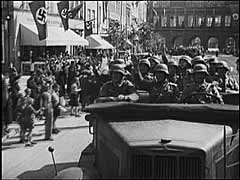
In this German newsreel footage, Hitler addresses members of the SA and the SS in the Sportpalast, a sports arena in Berlin, Germany. He thanks them for their support and sacrifice during the Nazi struggle for power.
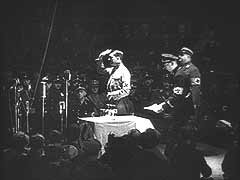
This footage shows the Reichstag (German parliament) building on the day after it was set on fire. While the origins of the fire on February 27 are still unclear, Hitler blamed Communists for the incident. The Reichstag Fire Decree of February 28, 1933, suspended constitutional guarantees. Communist and Socialist deputies were expelled from the parliament. Shortly after the decree was issued, the Nazis established concentration camps for the internment of political opponents.
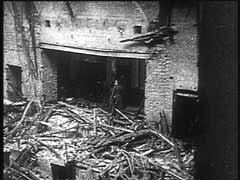
On the night of February 27, 1933, an unemployed Dutch construction worker named Marinus van der Lubbe set fire to the Reichstag (German parliament) building, causing serious damage. The Nazis blamed the Communists for the fire and claimed emergency powers to crush all opposition. Bolstering Nazi claims, the police also arrested three Bulgarian members of the Communist International, who were in Germany at the time, and a leading German Communist. Despite Nazi claims, however, responsibility for the fire…

Denmark signed a nonaggression pact with Germany in 1939, hoping to maintain neutrality as it had in World War I. Germany, however, broke the agreement on April 9, 1940, when it occupied Denmark. King Christian X remained on the throne, and the Danish police and government reluctantly accepted the German occupation. This footage shows the German presence in the occupied Danish capital, Copenhagen. In 1943, as German policies towards Denmark toughened, the Danes would form one of the most active and…
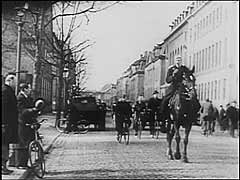
During World War II , the American Friends Service Committee, a Quaker relief organization, provided food, shelter, and other aid to thousands of Jewish refugees—especially Jewish children—in France. The Quakers were active throughout France, even in areas occupied by German forces. In this footage, Quaker relief workers feed children at one of the Quaker-established schools in Marseille in the unoccupied southern zone of France.
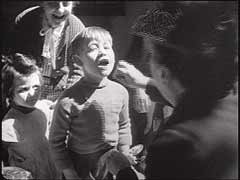
The Dachau concentration camp, northwest of Munich, Germany, was the first regular concentration camp the Nazis established in 1933. About twelve years later, on April 29, 1945, US armed forces liberated the camp. There were about 30,000 starving prisoners in the camp at that time. The film seen here was edited from original footage shot by Allied cameramen as liberating troops entered Dachau. It was discovered in the archives of the Imperial War Museum in 1984 and was never completed.
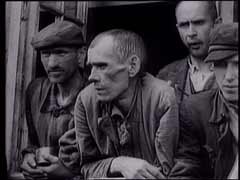
The Dachau concentration camp, northwest of Munich, Germany, was the first regular concentration camp the Nazis established in 1933. About twelve years later, on April 29, 1945, US armed forces liberated the camp. There were some 30,000 starving prisoners in the camp at that time. In this footage, soldiers of the US Seventh Army feed and disinfect survivors of the camp.
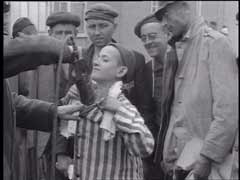
US forces liberated the Dachau concentration camp in Germany in April 1945. Here, survivors of the camp stand during the singing of "Hatikva" ("Hope") before Rabbi David Eichhoren, a US army chaplain, leads one of the first Jewish prayer services after liberation.
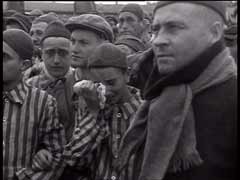
About a million Roma (Gypsies) lived in Europe before World War II. The largest Romani community—of about 300,000—was in Romania. This film shows a Romani (Gypsy) community in Moreni, a small town northwest of Bucharest. Many Roma led a nomadic lifestyle and often worked as small traders, craftsmen, merchants, laborers, and muscians.
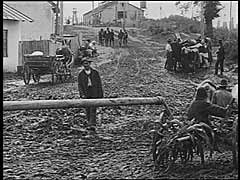
We would like to thank Crown Family Philanthropies, Abe and Ida Cooper Foundation, the Claims Conference, EVZ, and BMF for supporting the ongoing work to create content and resources for the Holocaust Encyclopedia. View the list of donor acknowledgement.